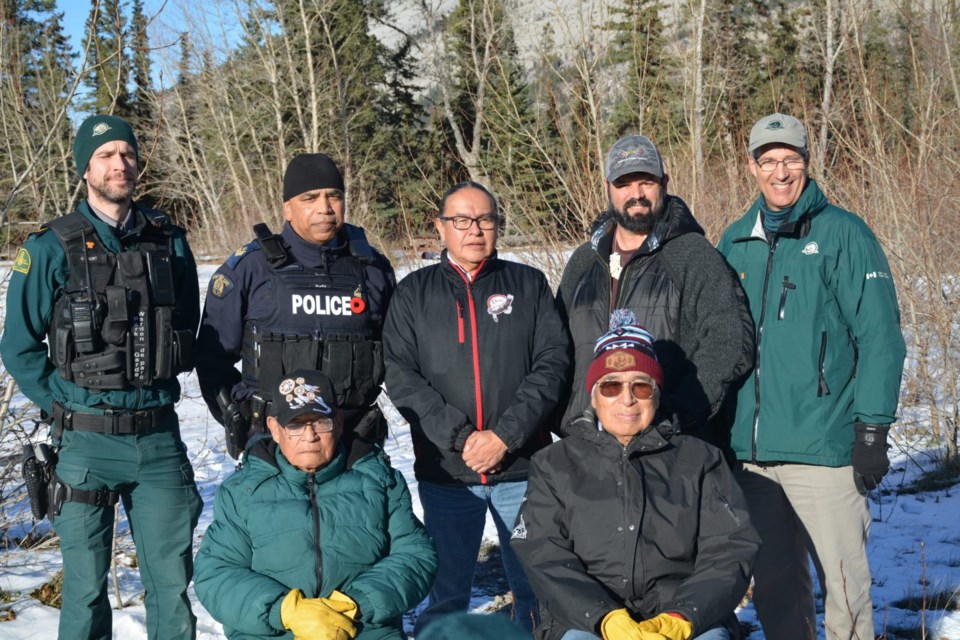“For us at Simpcw, the reawakening of the historical ties and the agreement we’ve had with our neighbours, our friends, our relatives that pre-dates Canada, pre-dates Alberta, pre-dates Jasper,” said Kúkwpi7 (Chief) for Simpcw George Lampreau.
“People need to know the true history of what happened here.”
Lampreau said the Simpcw people lived here in harmony since time immemorial until Jasper National Park was created. When that happened, all Indigenous people were forcibly removed.
“People don’t understand that. They say, ‘We should all be equal nowadays ... forget the past.’ Well, it’s pretty hard when we lived here for thousands of years, and then we were told to move because they wanted to create a park so that everyone else can enjoy it but us.”
Chief Aaron Young of the Chiniki First Nation, one of the three nations that comprise the Stoney Nakoda First Nation, noted how his late mother and uncles told him how they had been a people who shared.
“We were not here to take anything in possession. We were here to share and work collectively. If we don’t, it will divide and conquer us.”
He retold the story of how his people first faced settlers who were coming to take the land for themselves. The Stoney way was to welcome the newcomers with the belief that they would strengthen the Stoney people as human beings. They decided to hear what settlers could teach them, and they would teach them what they knew in return.
“Since then, of course, times have changed,” Young said.
The two First Nations gathered for a harvest, which included a hunt. The event was conducted with the agreement and participation of Parks Canada and the RCMP. The Simpcw and the Stoney people intend to continue the tradition every four years.
Elder John Wesley of the Stoney Nakoda First Nation spoke of how much he appreciated the moment and for what it means for what is to come.
“We’re close to the Snaring River. You look that way, you can see those two mountains. It’s part of a snaring. That’s how we go into there to get us back together here today, and to move forward. To think of that and move forward. We can tell the mountains show us the river. They snare us together here and move forward working together.”
Elder Henry Holloway added how important it was to be connected to the land because of what it can teach people.
“We’ve always believed in Nature. Nature has a way of speaking to us. Nature has a way of interpreting things that are happening surrounding us ... and will affect the future. Snaring brings us together,” he said, emphasizing how it brought the Indigenous government together with the Government of Canada as represented by Parks Canada and the RCMP.
“In order to communicate, leaders have to come together,” Holloway added.
“This is a very historic moment here where we have our leaders and our representatives from different governments are here. With our leaders, we have the RCMP here to support us. It’s honourable to us – to our future generation – that this must continue to build a better understanding to better educate our future generations so that this will continue and maybe we can protect Mother Earth.”
The fact that the area was near the southern edge of the Chetamon Wildfire was not lost on Lampreau. He offered that symbolism as a teachable moment.
“Historically, we would have burned the areas to revive them, to get the new plants, to get the new medicines growing, to get the berries growing, but because this is a national park, that right was taken away from us: to live, to occupy, to hunt, to share, to come together. That’s what it’s about now is coming together, and educating the general public on what the history is. We can’t forget our past. It’s always said if you forget your past, you’re going to repeat it. We don’t want to see that happen. We want to see our children playing here, years from now. We’ve set the stage. They’re going to remember this day because of this agreement, because of the relationship we’re building and the direction we’re going.”
Jasper National Park Superintendent Alan Fehr said that the harvest was also “tremendously important” for Parks Canada, which has been working with the Simpcw and Stoney Nations for many years.
“When the two nations approached us about their desire to reawaken, to revitalize the treaty between them and to have a harvest as part of that ... it was a real honour for us to get to help facilitate that,” Fehr said.
“We have a lot of mutual goals, shared goals related to the conservation of wildlife and the environment in the park as well as to ensure the safety of all the participants in the public in this really historic moment.”




